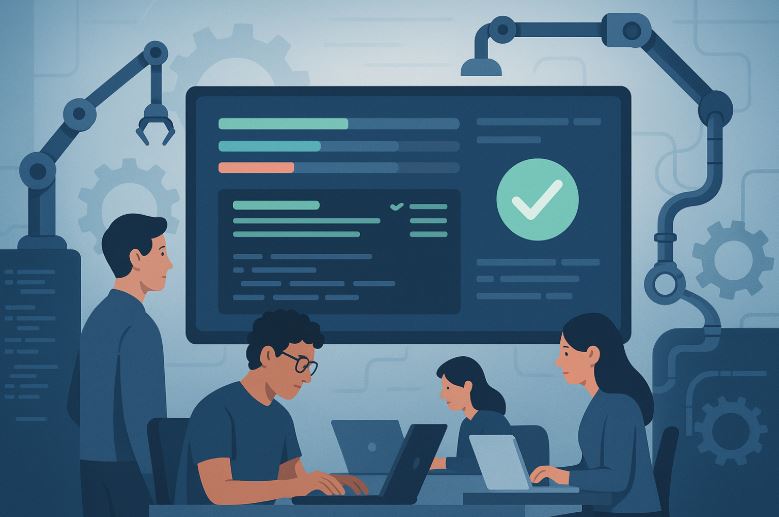
What ensures the reliability of software when teams push code every hour or day? How do organisations manage code conflicts, bug detection, and delivery speed in modern software development environments?
The answer lies in Continuous Integration (CI), a software engineering process that automates the build and test stages of development. As development practices have shifted toward agility and scalability, the need for early and continuous validation of software has become more critical than ever.
Continuous Integration allows developers to integrate code into a shared repository frequently. Once merged, the code automatically triggers a build process followed by automated testing. This practice ensures that the integrated code does not disrupt the stability of the software and helps identify issues early, reducing the cost and effort involved in fixing them later.
What Is Continuous Integration and How Does It Work?

Continuous Integration is the foundational step in the CI/CD pipeline. It enables development teams to merge changes to a central branch multiple times a day. Each integration triggers a series of automated steps, ensuring that the codebase remains consistent and functional.
Here’s a breakdown of a standard CI workflow:
- Code Modification: Developers work on code in isolated branches or local environments.
- Version Control Push: Changes are pushed to a shared repository, such as Git.
- Build Trigger: A CI tool detects the update and begins compiling the code.
- Automated Testing: Test scripts are executed to check for issues.
- Feedback Loop: Results are reported instantly, alerting developers of any errors.
- Deployment Preparation: If successful, the code is considered ready for staging or production deployment.
This process creates a feedback loop that is essential for modern software development, where speed and quality are equally important.
What Are the Key Steps of the Continuous Integration Process?
While different teams might have variations, the core CI process typically follows these five essential steps:
| Step | Description |
| Code Changes | Developers implement new features or fix bugs in their local environments. |
| Push to Repository | Code is committed and pushed to a shared version control system. |
| Build Process | A CI server (e.g., Jenkins, GitLab CI) initiates a build to compile code and generate binaries or artefacts. |
| Automated Testing | Unit, integration, and sometimes UI tests are executed to validate the build. |
| Feedback and Staging | Results are analysed. If successful, the code moves to staging or is prepared for production deployment. |
These steps ensure a repeatable, reliable process where integration happens seamlessly and continuously.
Why Are Automated Builds and Testing Essential to Continuous Integration?

Without automation, Continuous Integration would be a manual, error-prone process that defeats its own purpose. Automated builds compile and validate the integrity of the code, while automated testing checks the logic and performance of the application. Together, they form the backbone of CI.
Automated builds prevent broken code from entering shared branches by verifying the buildable state of new changes. Automated tests, ranging from unit tests to end-to-end scenarios, ensure the application behaves as expected.
Moreover, automation fosters confidence in frequent releases. It eliminates repetitive manual work and allows developers to focus on writing high-quality code.
What Are the Differences Between Continuous Integration, Continuous Delivery, and Continuous Deployment?
Although part of the same delivery pipeline, Continuous Integration (CI), Continuous Delivery (CD), and Continuous Deployment (CD) each serve distinct roles.
| Practice | Automation Level | Description | Manual Involvement |
| Continuous Integration | High | Code is integrated and tested automatically | Required for code commits |
| Continuous Delivery | Medium-High | Code is automatically prepared for release | Manual approval required |
| Continuous Deployment | Full | Code is deployed to production automatically | No manual steps needed |
CI ensures code is ready to be delivered. Continuous Delivery allows teams to release code when appropriate, while Continuous Deployment goes one step further by automating the entire release process to production.
These three practices, when combined effectively, create a robust and reliable DevOps pipeline.
How Does CI Improve Software Quality and Development Speed?
The benefits of Continuous Integration are extensive, influencing code quality, team collaboration, and overall project velocity.
By catching bugs early through automated testing, CI reduces the risk of defects in production. Developers are alerted instantly when something breaks, enabling immediate resolution before moving onto another task. This immediate feedback loop minimises context switching and development lag.
Furthermore, Continuous Integration supports:
- Rapid iteration and agile workflows
- Consistent environments across dev, test, and staging
- Reduced manual testing efforts
- Simplified release cycles and fewer integration conflicts
With fewer delays and more reliable code, software development becomes faster, more predictable, and easier to scale.
Which Tools Are Commonly Used in Continuous Integration?

Several tools have become industry standards for automating builds and testing in a CI environment. The choice depends on factors like team size, preferred language, and integration needs.
| Tool | Key Features | Use Case |
| Jenkins | Highly extensible, large plugin library | Enterprise and complex pipelines |
| GitLab CI | Built-in within GitLab, integrated CI/CD | All-in-one DevOps management |
| Travis CI | Cloud-based, GitHub integration | Open-source projects |
| CircleCI | Fast, scalable, Docker support | Performance-sensitive environments |
These tools can be integrated with testing frameworks such as JUnit, PyTest, and Cypress, allowing seamless execution of test suites during each build.
What Is the Role of CI/CD in the DevOps Ecosystem?
CI/CD practices are central to the DevOps methodology. DevOps aims to bring together development and operations through automation, continuous feedback, and shorter release cycles.
Continuous Integration ensures that every code commit is tested and verified. Continuous Delivery then moves that validated code to a staging environment. Continuous Deployment, if implemented, automates the final push to production.
By automating every stage of software delivery, CI/CD eliminates the delays and risks traditionally associated with releasing code. This results in:
- Reduced time-to-market
- Enhanced collaboration
- Improved reliability and system uptime
CI/CD turns software delivery into a smooth, predictable process, a core goal of any DevOps strategy.
What Is the Difference Between Automated and Autonomous Processes in CI?

The terms “automated” and “autonomous” are often confused, yet they represent different concepts. Automation refers to the execution of tasks via scripts, tools, or machines without direct human intervention. In contrast, autonomy involves decision-making and adaptability, a trait found in more intelligent systems.
For example, in the context of vehicles:
- Automated: A car with an automatic gearbox shifts gears without driver input.
- Autonomous: A self-driving car makes decisions about navigation and speed without human control.
In CI, tasks like code compilation, test execution, and report generation are automated — they do not make decisions but follow predefined rules.
How Should Teams Adopt CI When Transitioning from Traditional Methods?
Transitioning to CI is more effective when done incrementally. For new projects, integrating CI from the start is ideal. For existing systems, begin with basic test automation and automated builds.
Start by:
- Creating unit tests for core functionality
- Setting up a CI server or cloud pipeline
- Automating deployment to staging environments
As your test coverage improves and your team gains confidence in automation, more sophisticated processes such as Continuous Delivery or Continuous Deployment can be introduced.
A phased adoption not only reduces disruption but also helps align other teams, such as QA, documentation, and operations, with the new workflow.
Frequently Asked Questions
What is the purpose of Continuous Integration in software development?
The purpose is to reduce integration issues by testing code changes frequently and automatically, ensuring code stability and quality.
Is Continuous Integration only for large teams?
No, CI benefits teams of all sizes by improving code quality, enhancing collaboration, and enabling faster feedback.
Can CI be used without automated testing?
Technically yes, but its effectiveness would be drastically reduced. Automated testing is central to validating code in CI.
How frequently should developers push code in a CI environment?
Developers should ideally push code at least once daily to maintain small, manageable changes that are easier to integrate and test.
What are the risks of skipping CI?
Without CI, teams may face integration conflicts, higher defect rates, and slower release cycles due to poor visibility into code quality.
How is a CI server different from a deployment tool?
A CI server focuses on building and testing code, whereas deployment tools handle the delivery of validated code to various environments.
What is the best way to measure the success of a CI implementation?
Metrics such as build success rate, test coverage, deployment frequency, and mean time to recovery (MTTR) can gauge effectiveness.